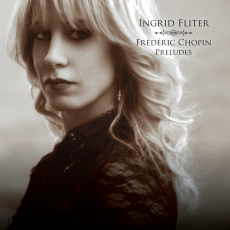Ingrid Fliter - Chopin: Preludes - Audiophile Audition
Ingrid Fliter imaginative and poetically realizes the Rosetta Stone of Chopin's Preludes, along with lucid mazurkas and two nocturnes.
Argentine pianist Ingrid Fliter (b. 1973), a recipient of the 2006 Gilmore Artist Award and a Silver Medal Winner of the 2000 Chopin Competition in Warsaw, has already proven herself an instinctive, fleet proponent of the Chopin style. Fliter here (rec. 9-12 June 2014) addresses the 1838-1839 Chopin Op. 28 cycle of Preludes, his emendation to a didactic form developed by Cramer and Hummel, but obligated in Chopin's case to Johann Sebastian Bach's model of the perfect miniature that synthesizes drama and architecture. Like Bach, Chopin infused his iconoclast's polyphony into works that often serve as compressed sonata movements or dance forms, like waltzes and mazurkas. The slow preludes achieve a static, melodic ethos easily suggestive of a nocturne, to wit, the haunted F-sharp Major. The more bravura preludes serve as etudes that resound with active bass or ornamented figures and proceed to a stunning fermata. In terms of variety of affect, these works constitute a Rosetta Stone for the Romantic piano bathed in - to borrow Carl Schachter's phrase - "a free, idiomatically pianistic counterpoint."
Fliter possesses a striking keyboard tone, often capable of lush girth, as in her F-sharp Minor Prelude. The most audacious of the set, the A Minor, unnerves us with its asymmetries, cast in an alabaster sound that anticipates Moussorgsky's Gnomus. Her bass line in the E Major assumes a granite proportion in tragic dialogue with the treble. Liquid pearly play in the C-sharp Minor makes it an etude in its own laconic terms. The B Major ripples with bel canto, to be followed by the national colors of a militant mazurka in the G-sharp Minor. For the more familiar preludes, the D-flat Major "Raindrop" or the A Major, Fliter does not rely on over-played sostenuto or exaggerated rubato; and in this manner her playing more than once reminds us that Artur Rubinstein could step aside and allow these works to express themselves. On the other hand, a fiendish miniature like the F-sharp Minor and F Minor leave the tracks of Blake's "Tyger." My own favorite, the A-flat Major Prelude, rings with nostalgic warmth, although the nature of that reminiscence remains eternally elusive. Rather close miking on the funereal C Minor has Fliter's breathing captured in the opening cadences. The final diptych, the F Major - as slow a rendition as I have heard- and the D Minor, move from an almost ‘galant' evocation of a water piece to a Dantesque descent into the abyss. Perhaps not since Ivan Moravec have we enjoyed so thoroughly an integrated, affective reading of this monumental cycle.
The dance form of the mazurka, too, achieved a remarkable metamorphosis through Chopin, who raised its peasant or folk status to a dramatic height through rhythmic invention and contrapuntal subtlety. The A Minor, Op. 17, No. 4 (1833) exploits a Polish kujawiak that permits Fliter a wide berth of expressive rubato. The E Minor from the same opus group invokes a shepherd's pipe a dance-rhythm that Grieg would find attractive. The C-sharp Minor from Op. 63 (1846) achieves a rarified simplicity, rustic and exotic at once, rife with Fliter's capacity for color. The C-sharp Minor Mazurka, Op. 50, No. 3 (1842) remains among the most imposing of Chopin's essays in the form. Its strong national impulse, buttressed by contrapuntal stretti, develops in the manner of a compressed sonata, the swaying motion colored by shifting half steps and enharmonic puns. Fliter concludes the mazurka group with the 1830 F-sharp Minor, Op. 6, No. 1, Chopin's early imposition of strict polyphony upon an otherwise ingenuous folk idiom. Fliter bequeaths the piece a persuasive lilt that easily shifts into a minor explosion of poetic power.
The two nocturnes Fliter selects capture Chopin's eminently vocal, instrumental style. Each presents a Bellini-like aria or pair of arias that evolve, lilt, and then droop into a dramatic episode that shimmers with Byronic possibilities. Fliter breezes through the respective ornaments of the B Major (1830) and D-flat Major (1835) with unaffected spontaneity and plastic pulsation. We have spent our 73 minutes with a natural disciple of the Chopin style, fluent and imaginatively informed at every measure.

